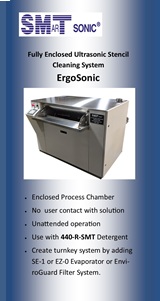|

|
|
| Ask the Experts | |||||||
|
|||||||
|
October 26, 2011 - Updated October 24, 2011 - Originally Posted OSP Poor WettingWe are experiencing poor wetting on one OSP coated PCB using a lead-free no-clean paste? We see this problem on just one board part number. All other similar boards reflow fine. Where should we look to solve this problem? J. G. |
|||||||
| Expert Panel Responses | |||||||
|
The reason you see it on one particular PWB part number and not other PWB part numbers is probably because that particular lot of boards was allowed to be exposed for too long of a time between PWB fabrication and OSP application. This allows the exposed copper to oxidize somewhat, and during reflow the OSP burns off, and the molten solder attempts to form an intermetallic bond to the copper underneath. The oxide barrier, if present, is what prevents good wetting, or results in maybe not quite as good of wetting. Sometimes you can visually see this oxidation, in that the PWB pads will display a slightly darker brown tint, sort of like the difference between a 1935 wheat penny and a 2005 Lincoln penny. However, the darker color can also be caused by thicker applications or different OSP products and may solder up just fine, so you cannot go by visual appearance alone. Another reason may be the process flow of that particular PWB part number, as opposed to the process flow of others. For example, an OSP-coated board that is double-sided, and goes through a selective solder or wave solder process as well, and perhaps undergoes BGA rework, has been exposed to no less than 4 reflow processes, and subsequently at least 4 wash processes. By the time the hand soldering or touchup is done, there may be very little OSP coating left on the remaining pads, and thus more wetting issues, progressively getting worse the further along the process the PWB goes. On the other hand, a single-sided SMT board with no subsequent reflow processes followed by a single wash is probably going to contribute less to the overall DPMO. Some PWB fabricators send their boards to an outside service for the OSP application, and some OSP applicators may be better than others. Also, I know firsthand from experience that some OSP products are not as good as others. I encourage my clients to specify the OSP product on the fabrication drawing, if possible, and work only with PWB vendors that produce good results. When soldering with OSP protective finish, I have found that certain no-clean paste fluxes react with the OSP, which is also a hard flux coating, and the resulting solder wetting leaves something to be desired. You may wish to contact the fabricator, identify the OSP product used, and contact them for a recommended lead-free no-clean paste that has proven to be more compatible. However, if you do this, be sure to fully qualify the paste. You do not want to trade one problem for another. But I would definitely notify your fabricator so they are aware of the issue. They cannot fix what they don't know is broken, or maybe not working quite so well. Good luck, and let me know how this shakes out.
Advanced Engineer/Scientist General Dynamics Richard D. Stadem is an advanced engineer/scientist for General Dynamics and is also a consulting engineer for other companies. He has 38 years of engineering experience having worked for Honeywell, ADC, Pemstar (now Benchmark), Analog Technologies, and General Dynamics.
Some of the common solderability issues from OSP can occur:
Quality Manager Sunstone Circuits Kevin is part of the Sunstone Management team. In his role as Quality Assurance Manager, Beattie’s 25+ year background in Printed Circuit Board manufacturing is a tremendous asset to the Sunstone team. In addition, he brings valuable experience from his previous roles in the following areas: process engineering, new process introductions, support of nearly every manufacturing process, and extensive knowledge of Continuous Improvement, ISO, IPC, and various other industry requirements.
|
|||||||
| Submit A Comment | |||||||
|
Comments are reviewed prior to posting. You must include your full name to have your comments posted. We will not post your email address. |
|
Free Newsletter Subscription
Circuitnet is built for professionals who bear the responsibility of looking ahead, imagining the future, and preparing for it. Insert Your Email Address |
|

|



